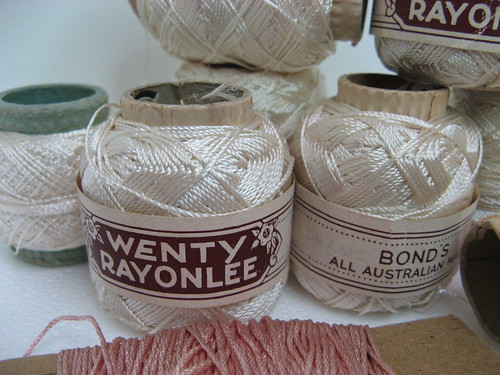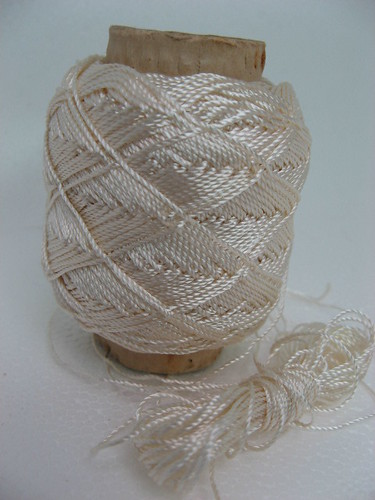wrote and told me about a lovely Victorian needlecase she had seen on ebay:


Sandy was wondering what the heavy silky thread was that had been used.
I thought I had some similar that I'd inherited from my mother but when I finally dug it out, I can see it is not the same. Mine is a rayon and has more of a twist to it. I'm not familiar enough with antique needlework to know what would have been used on the needlecase, rayon was being produced in the 1800's but I'm thinking maybe this one was a thick silk.
These threads of mine are from the Bonds mills, and are labelled as "crochet and knitting threads"
I would assume that as they are called "Wenty Rayonlee" they would have come from the Bonds factory at Wentworthville in Sydney.
Bonds was established in 1915 by an American, George Alan Bond, who started importing women's hosiery and gloves. In 1917 he began manufacturing hosiery in Redfern, Sydney. In 1918 he moved to Camperdown and began also making underwear. In 1932, Bond built Australia’s first cotton spinning mill at Wentworthville in western Sydney.
The company went into liquidation in 1929 and a public company, Bonds Industries Limited was established. In 1970 the company merged with Coats Paton Pty Ltd. (Coats were thread manufacturers) In 1987 the company was taken over by Pacific Dunlop. In 2001 the company was sold to form a separate entity, ‘Pacific Brands Holdings Pty Ltd’. At that time also the spinning mill was closed.
In 1938 Bond's asked their advertising agency to develop a campaign to sell men's athlectic singlets and "Chesty Bond" was created. He became a comic strip which ran in Sydney papers for the next 20 years.
In the mid 1960's the company decided Chesty was no longer suitable to represent the diversity of the company but Chesty refused to go away. Public demand put him firmly into Australian iconic history and he celebrated his 60th birthday in 1998 at the Museum of Modern Art.




3 comments:
nice history lesson/ story, and what a needle case. wow.
That needlecase is gorgeous, it must have taken some time to embroider such an intricate and stunning design. Thanks for the history lesson.
glad you found it interesting, I like finding out the history behind objects like this
Post a Comment